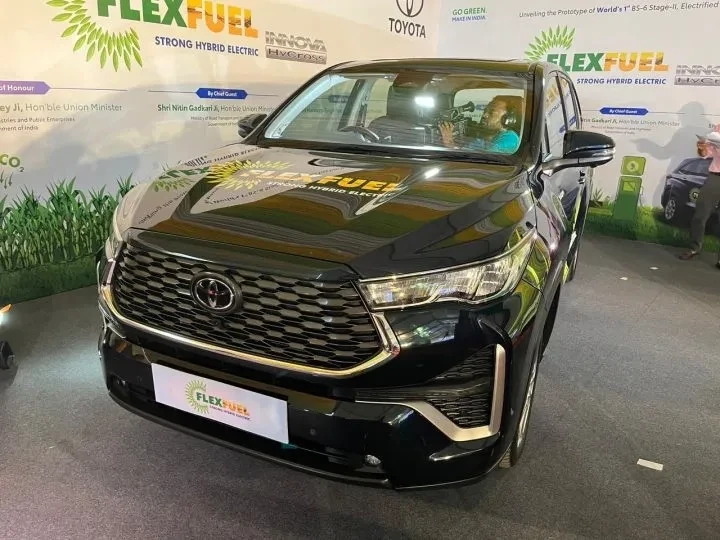Electric Flex Fuel Vehicle: On a recent Tuesday, three Union ministers revealed the world’s inaugural prototype of an electric flex fuel vehicle produced by Toyota Kirloskar. This groundbreaking vehicle, named the Toyota Innova Hycross, operates on ethanol and adheres to the BS-6 emission standards. This unveiling aligns with the government’s current emphasis on adopting alternative fuels to curtail crude oil imports and combat air pollution.
“Therefore, as in the case of a Strong Hybrid Electric Vehicle (SHEV), which can run 40% percent of the distance and 60% of the time in electric mode (under specific test conditions) with the petrol engine shut off, the use of the electric powertrain in combination with the flex fuel engine overcomes this challenge with enhanced fuel efficiency,” the Toyota Kirloskar Motor said.
The innovative Toyota Innova Hycross is designed to function on a blend of ethanol and petrol, with the capacity to run on a blend of up to 85% ethanol. The vehicle is equipped with an electric powertrain, marking a significant step toward reducing carbon emissions in the transportation sector. The event saw the participation of Union ministers Nitin Gadkari, Hardeep Singh Puri, and Mahendra Nath Pandey, who collectively hailed this achievement as a significant stride toward decarbonizing transportation.
Speaking at the event, Gadkari said, “Ethanol being an indigenous, clean and renewable fuel holds a promising future for India. The government’s focus on ethanol is for achieving energy self-reliance, spurring the incomes for farmers and having a better impact on the environment. The government’s plan is not only to diversify agriculture surpluses towards the energy sector but also generate wealth from waste using 2G technology for producing ethanol from bio-waste.”
One of the primary challenges associated with flex fuel vehicles
One of the primary challenges associated with flex fuel vehicles, which can utilize more than 20% ethanol blended with petrol, is the reduced fuel efficiency caused by ethanol’s lower energy density. To address this challenge, the global automotive industry is introducing electrified flex-fuel vehicles that combine a flex-fuel engine with an electric powertrain. This innovative approach aims to overcome the efficiency drawbacks of traditional flex fuel vehicles.
The timing of this vehicle launch is particularly noteworthy due to the Indian government’s target of achieving a 20% ethanol blending in petrol (E20) across the nation by March 2025. Consequently, the availability of ethanol fuel is expected to be readily accessible when the Toyota Innova Hycross model becomes available in the market. This achievement represents a significant step forward in India’s pursuit of sustainable and eco-friendly transportation solutions.
“Alternative fuels will indeed change the whole landscape of India’s economy and it will not only make farmers Annadattta to Urjadatta but also providers of Bio-aviation fuel,” he added.
Keep watching our YouTube Channel ‘DNP INDIA’. Also, please subscribe and follow us on FACEBOOK, INSTAGRAM, and TWITTER.


